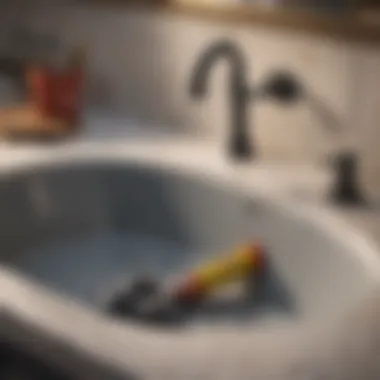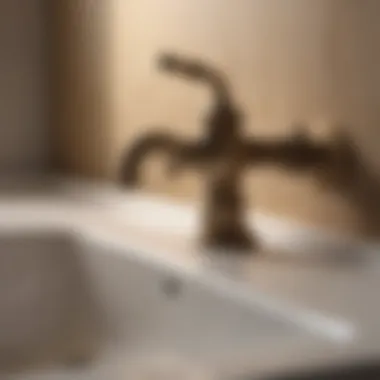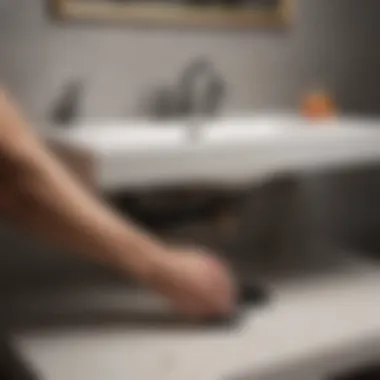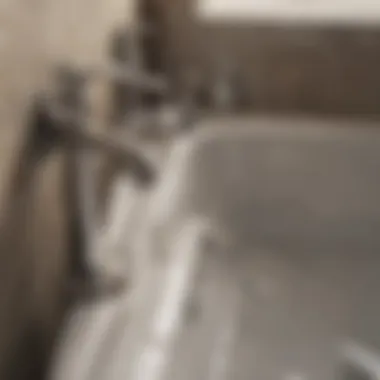Replacing a Bathroom Sink Trap: An In-Depth Guide


Intro
Replacing a bathroom sink trap is often seen as a straightforward task, yet it encompasses a range of considerations that every homeowner should understand. The sink trap plays a vital role in the plumbing system, preventing unpleasant odors from entering the home while also collecting debris. When it's necessary to replace this component, various factors must be taken into account, such as the right tools, the specific type of trap being installed, and the broader implications for overall plumbing health.
In this guide, we will explore the importance of the sink trap, the steps involved in replacing it, and the common errors to avoid in the process. Caring for this part of your home can significantly enhance hygiene and functionality, contributing to a healthier environment.
Reasons for Replacement
There are several reasons one might consider replacing a bathroom sink trap. Common signs include:
- Leaking: If water is pooling under the sink, it's a clear indicator that the trap may be compromised.
- Slow draining: A trap blocked by debris may result in slower drainage, indicating the need for replacement.
- Bad odors: Foul smells from the sink can signal a malfunctioning trap, requiring immediate action.
Understanding these issues is crucial for maintaining bathroom hygiene and functionality.
Necessary Tools
Before beginning the replacement process, ensure you have the following tools:
- Adjustable wrench
- Pliers
- Bucket to catch water
- Replacement trap
- Plumber's tape
Having these tools on hand ensures a smoother process.
Step-by-Step Instructions
- Turn off the water supply: Locate the valves under the sink and shut them off to prevent any leaks while working.
- Place a bucket: Position a bucket under the sink to catch any excess water that may drain out during removal.
- Loosen the trap: Using your adjustable wrench, carefully loosen the slip nuts on both ends of the trap. Be cautious as water may begin to flow out.
- Remove the old trap: Detach the trap and examine it for any signs of damage.
- Install the new trap: Align the new trap and secure it with the slip nuts. Use plumber's tape on threads to ensure a watertight seal.
- Test for leaks: Turn the water supply back on and check for any leaks around the trap.
Ensure each step is executed carefully to avoid damage.
Common Mistakes to Avoid
When replacing a sink trap, be aware of these frequent mistakes:
- Skipping the leak test: Always test for leaks after installation; ignoring this step can lead to larger issues later on.
- Inadequate cleaning: Ensure that the area around the trap is clean before installation to avoid further blockage.
- Using wrong parts: Verify that the replacement trap is suitable for your plumbing system.
Awareness of these mistakes can save time and reduce frustrations.
Maintenance Tips
To extend the lifespan of your sink trap, consider these maintenance tips:
- Regularly inspect for leaks or signs of wear.
- Avoid flushing non-degradable materials down the sink to decrease blockage risk.
- Clean the trap periodically to eliminate build-up.
Maintaining your sink trap contributes to the overall health of your plumbing system.
Epilogue
Understanding the process and importance of replacing a bathroom sink trap enhances your plumbing expertise. Through proper maintenance, you can reduce the likelihood of unpleasant odors and water issues, ensuring a clean and functional bathroom for years to come.
For more detailed resources, you can visit Wikipedia or Britannica. If you want to join discussions about DIY repairs, consider visiting reddit.
Readiness to learn and execute plumbing tasks significantly elevates one’s capabilities as a homeowner.


Understanding the Bathroom Sink Trap
Understanding the bathroom sink trap is essential for homeowners who wish to maintain their plumbing systems effectively. The sink trap plays a significant role in ensuring proper drainage while preventing unpleasant odors from entering the home. When you know how a sink trap operates and its importance, you can better appreciate the signs that indicate it may need replacement. This knowledge will equip you with the information necessary to make informed decisions about plumbing maintenance, contributing to both your comfort and health in your home environment.
What is a Sink Trap?
A sink trap is a plumbing device designed to hold a small amount of water, which creates a barrier preventing sewer gases from entering the home. It is typically made of PVC or metal and is installed beneath the sink. The trap resembles a U-shape, with the lower part holding water at all times. By retaining this water, the sink trap effectively blocks harmful odors and gases while allowing wastewater to flow through.
Key Functionality of a Sink Trap:
- Odor Prevention: The primary function is to stop sewer odors from permeating into living spaces.
- Debris Filtration: It collects small debris that may otherwise clog the plumbing system.
- Prevention of Backflow: A properly functioning trap prevents wastewater from flowing back into the sink.
Importance of the Sink Trap in Plumbing
The sink trap is an integral part of any plumbing system. Its absence or malfunction can lead to several severe issues. For instance, without a functioning trap, not only would unpleasant odors infiltrate your home, but also the potential for drainage problems increases. Over time, this can lead to significant plumbing issues that may require professional intervention.
Benefits of a Properly Functioning Sink Trap:
- Health Considerations: Prevents harmful gases and bacteria from entering your living area, promoting a healthier environment.
- Cost-Effective Maintenance: Regularly checking and replacing your trap, when necessary, can save you from extensive plumbing issues that lead to costly repairs.
- Improved Hygiene: A well-maintained trap enhances the overall hygiene of your bathroom, contributing to a more pleasant living space.
A simple yet vital component like the sink trap offers substantial benefits that influence both the functionality and safety of your plumbing system.
Indications for Replacement
Replacing a bathroom sink trap is an essential aspect of plumbing maintenance. The trap plays a crucial role in preventing foul odors from entering your home and ensuring efficient drainage. Over time, various factors can lead to the deterioration of this component, signaling the need for a replacement. Recognizing these signs early is beneficial for both hygiene and functionality.
One of the primary reasons to consider a replacement is the efficiency of drainage. If you notice that water drains slowly or not at all, it may indicate that the trap is clogged or damaged. This could lead to water pooling, which may cause further plumbing problems and even water damage in your home. Thus, prompt attention to these symptoms can save homeowners from expensive repairs in the future.
Signs of Trap Failure
- Unpleasant Odors: One of the first indications of trap failure is the emergence of foul smells around the sink area. A functioning trap holds a small amount of water, which creates a barrier to prevent sewer gases from seeping into your home. If these odors become noticeable, it’s time to inspect the trap.
- Visible Cracks or Rust: Inspecting the trap visually can reveal cracks or signs of rust. These defects can compromise the trap’s ability to retain water and perform its intended function, leading to leaks and additional problems.
- Frequent Clogs: If you are experiencing frequent clogs, it may signal that your trap is no longer able to handle waste and debris efficiently. Repeated clogs can strain your plumbing system.
- Water Leaks: Any signs of water leaking from the trap connection or from the trap itself can indicate the need for replacement. Small leaks can escalate and cause significant issues over time.
Common Problems Linked to a Damaged Trap
A damaged trap can lead to various problems that affect not only the sink's performance but also the overall hygiene of your home.
- Sewage Backup: If the trap is damaged, it might not be able to prevent sewage backflow. This can lead to unsanitary conditions and potential health hazards in your home.
- Increased Pest Activity: With faulty traps allowing odors and gases to pass through, this can also attract pests, such as insects or rodents, to your bathroom area.
- Structural Damage: Over time, persistent leaks caused by a damaged trap can result in water damage to your cabinetry or flooring, leading to more costly repairs.
- Higher Water Bills: Excessive leaking from a faulty trap will lead to higher water consumption. This may not be noticeable at first, but over time, it can result in an increased water bill.
Maintaining a functional bathroom sink trap is critical for a hygienic and efficient plumbing system. Being vigilant about the signs of trap failure can save homeowners from significant repairs down the road.
Tools and Materials Needed
Replacing a bathroom sink trap involves careful consideration of tools and materials. Using the right tools helps ensure a smooth process. It also minimizes the risk of damage to the plumbing or surrounding areas. The correct materials not only aid in a proper fit but also prolong the life of the installation.
Essential Tools for the Job
Before you begin the replacement, gathering the essential tools is crucial.
- Pipe Wrench: Useful for gripping and twisting pipes. It can make tight spots easier to handle.
- Adjustable Wrench: This tool is handy for turning fittings and nuts that require a firm grip.
- Plumber's Tape: Also known as thread seal tape; it is key for preventing leaks at threaded connections.
- Bucket: To catch any residual water from the old trap during removal.
- Towel or Rags: For cleaning up spills and ensuring a clean working environment.
- Hack Saw: Useful if you need to cut the pipes for a custom fit.
- Pliers: Regular or needle-nose pliers will help in gripping small components.
Choosing the Right Replacement Trap


Selecting the appropriate replacement trap is critical. Traps come in various styles, such as P-traps or S-traps, and each serves the same fundamental purpose yet has different fittings and configurations.
- Material: Traps are typically made from PVC, ABS, or metal. PVC is lightweight and resistant to corrosion. Metal traps may offer more durability but can corrode over time.
- Size: Measure the existing trap size and the mounting configuration. This step prevents mismatched parts that could lead to potential leaks.
- Style: Choose a trap design that suits your plumbing. If replacing an old trap, consider sticking to the same style to avoid complications in fitting.
- Manufacturer Recommendations: Look for replacements that align with the original manufacturer's specifications for the best results.
"Using the correct tools and materials simplifies the replacement process and enhances overall plumbing performance."
Furthermore, utilizing high-quality products will increase durability and reduce future maintenance needs. Always keep in mind the specific needs of your plumbing to make the best choice.
Preparation for Replacement
Preparing for the replacement of a bathroom sink trap is crucial. This stage sets the foundation for the entire process. Proper preparation minimizes the risk of accidents, makes the replacement smoother, and saves troubleshooting time later. A well-prepared workspace can help ensure that everything goes according to plan and that you can address potential complications.
Turning Off Water Supply
One of the first and most critical steps in preparing for the replacement is turning off the water supply. This ensures that you avoid any unwanted water flow during the task. Typically, the water supply can be turned off using the shut-off valves located under the sink. There are usually two valves: one for the hot water and another for the cold water.
- Locate both valves under the sink.
- Turn each valve clockwise until it stops. This action effectively cuts off the water flow to the sink and prevents potential flooding.
It is advisable to run the faucet briefly after turning off the supply. This will release any remaining water in the pipes, giving you a drier workspace.
Clearing the Area Under the Sink
A clutter-free environment will make the job easier. Before you begin, take time to clear out the area beneath the sink. Eliminate any items stored there, such as cleaning supplies, personal care products, or plumbing paraphernalia.
- Ensure you have ample room to maneuver.
- Remove any obstacles that might hinder easy access to the plumbing.
- Consider laying down an old towel or a plastic sheet on the floor to catch any potential spills. This reduces mess and protects your floor.
This preparation is often overlooked, yet it significantly contributes to the efficiency of the task. With everything in order, you are now ready to tackle the replacement process with confidence.
Step-by-Step Replacement Process
Understanding how to replace a sink trap is fundamental for maintaining your plumbing system. The success of this task revolves around following a systematic approach. A step-by-step process not only prevents mistakes but also ensures efficiency in execution. By diligently adhering to each phase, the risk of further complications can be significantly minimized. It is crucial to grasp the intricacies involved to safeguard the overall integrity of your plumbing.
Removing the Old Trap
The first essential step is to remove the old trap. Before you begin, make sure you have all your tools ready. A bucket or a pan will also be necessary to catch any residual water that may spill when the trap is taken out. To start, locate the connection points where the trap is affixed to the sink and the drainage pipe. Using a pair of adjustable pliers, carefully unscrew the slip nuts. They might be tight due to buildup over time, so patience is key. If you encounter rust or corrosion, applying a penetrating oil may help to loosen them. Once the nuts are unscrewed, gently pull the trap away from the sink and drainage pipe. Be cautious during this step as any sudden movements can cause spills.
Installing the New Trap
After successfully removing the old trap, it is now time to install the new one. Select a replacement trap that matches the specifications of the old one. Hold the new trap in place and align it with the sink connection and the drain line. Begin by hand-tightening the slip nuts onto the new trap. Ensure they are not overly tightened at this stage. Using pliers only when necessary, tighten them just enough to create a secure fit while avoiding warping the plastic. A good practice is to check the alignment before completely tightening. This aligns the pipe connections correctly, minimizing stress on the trap.
Securing Connections and Checking for Leaks
Once the new trap is installed, the next phase involves securing all connections. Increase the tightness of the slip nuts slightly with pliers, but again, do not overdo it. Tight connections will prevent leaks but excessive force can crack the fittings. After securing everything, it is important to conduct a leak test. Slowly turn on the faucet and observe the installation for any dripping or leaking. If you notice any, turn off the water and adjust the connections accordingly. A properly installed trap should have no leaks. Ensure you check every connection carefully; this can save you trouble in the future.
Remember, maintaining a leak-free plumbing system is not just about the installation but also about the vigilance to inspect connections periodically.
Completing these steps helps secure the plumbing system and enhances its functionality. Each stage, from removing the old trap to ensuring all connections are tight, is vital to successful installation and maintenance.
Post-Replacement Considerations
Once the bathroom sink trap has been successfully replaced, it is essential to evaluate its performance and longevity through careful post-replacement steps. This phase is not merely an afterthought but a critical part of the installation process. Ensuring that the new trap functions correctly while preventing future plumbing issues can significantly contribute to prolonged system efficiency and reduced maintenance costs.


Testing Your Sink
After installing the new sink trap, testing the sink is vital. Begin by restoring the water supply. Let the water flow for a few minutes to observe how the newly installed trap performs. Monitor for any signs of leaks or unusual noises that may indicate problems with the installation.
- Check for Leaks: Inspect the joints and connections of the trap. Water should not drip at any point. If you notice moisture accumulation, tightening may be needed.
- Observe Drainage: Ensure that water drains smoothly. Gurgling sounds or slow drainage can indicate blockages or misalignment within the plumbing.
- Assess Odor: A properly functioning trap should not emit foul smells. If odors persist, it could suggest improper sealing or an issue upstream in the plumbing.
"Taking time to test ensures your work was done correctly and safeguards against future inconveniences."
Maintaining Your New Trap
Maintaining your new sink trap is crucial for optimal operation. Maintenance activities can help in extending the life of the plumbing component and preventing frequent repairs. Here are some practical maintenance tips:
- Regular Inspection: Periodically check the trap for any signs of wear or leaks. Early detection can prevent more significant issues.
- Clean Regularly: Accumulated debris can lead to slow drainage. Periodic removal of buildup from the trap can enhance functionality. Use a soft brush or cloth for this task.
- Monitor Drainage Performance: Pay attention to how quickly the sink drains over time. Slowed drainage can be a sign of clogging, which should be addressed promptly.
Maintaining your new sink trap, combined with effective testing, ensures efficient plumbing in your home. By managing these elements, homeowners can avoid costly repairs and enjoy the benefits of a well-functioning bathroom sink.
Common Mistakes During Replacement
Replacing a bathroom sink trap may seem straightforward, but several common mistakes can undermine your efforts. Understanding these pitfalls is essential for achieving a successful installation. Ensuring proper function of the trap is critical not just for plumbing efficiency, but also for maintaining hygiene and preventing further issues down the line. Keeping an eye on potential mistakes can save time, money, and a lot of frustration.
Over-tightening Connections
One of the most frequent errors in sink trap replacement is over-tightening connections. This mistake can lead to several issues, including damage to the plumbing fixtures and increased chances of leaks. When connections are too tight, materials can become strained. Plastic connections may crack, while metal fittings can warp or thread can strip, leading to a poor seal.
• Proper Tightening: It is crucial to tighten connections until they are snug, but not excessively. A good rule is to use hand strength to secure the fitting, avoiding tools unless necessary.
• Leak Testing: After the installation, test for leaks by running water for a few minutes. If you see any drips, it might be a sign that a connection was either too loose or too tight.
Neglecting to Inspect for Other Issues
Another common mistake is overlooking other plumbing issues while focusing on the trap replacement. The sink trap is just one component of the plumbing system. Several factors can contribute to the need for replacement, and failing to address them may lead to recurring problems.
• Older Plumbing Systems: It is always good to assess the age and condition of the surrounding pipes. If they seem corroded or damaged, they might need repair or replacement as well.
• Clogs or Backups: Before replacing the trap, check for clogs further down the line. A trap may break due to excessive blockage upstream, which could lead to more serious plumbing issues.
• Mold and Mildew: If the area around the sink shows signs of water damage, mold or mildew might be present. This is a signal to check for leaks or moisture retention around the entire plumbing setup.
Always take the time to perform a thorough inspection before and after replacing the sink trap. It is better to address multiple issues at once rather than face repeated repairs.
Finale
In this article, the importance of understanding and effectively replacing a bathroom sink trap has been highlighted. A sink trap plays a fundamental role in plumbing systems, serving to prevent unpleasant odors from entering living spaces. Therefore, being knowledgeable about when and how to replace it is crucial for maintaining a functional bathroom.
Key elements discussed throughout the article include key signs that indicate the necessity for a replacement. Regular inspection and awareness contribute significantly to timely interventions, avoiding more extensive plumbing issues that could arise from neglect. By familiarizing oneself with the tools and processes required for a proper replacement, homeowners can engage proactively in home maintenance.
The benefits of successfully replacing a sink trap extend beyond aesthetics; they also include improvements to plumbing hygiene and overall system efficiency. With enhanced understanding gleaned from this guide, individuals are better positioned to make informed decisions, ensuring a sanitary and well-functioning bathroom.
By tackling potential problems before they escalate and equipping oneself with the right skills, homeowners not only protect their bathrooms but also enhance the integrity of their entire plumbing system.
Recap of Key Points
- A sink trap is an essential plumbing component that prevents foul odors.
- Signs of failure include leaks, corrosion, and bad smells.
- Proper tools are necessary for effective replacement, such as adjustable wrenches and sealants.
- Preparation is vital; ensuring the area is clear and the water is turned off can avoid mishaps.
- The replacement process involves removing the old trap and installing a new one, ensuring tight connections to prevent future leaks.
- Post-replacement testing and maintenance will prolong the life of the new trap and maintain plumbing hygiene.
Final Thoughts on Plumbing Maintenance
Maintaining a bathroom’s plumbing system goes beyond merely replacing components; it encompasses regular care and inspection. Simple actions, like checking seals or ensuring proper drainage, can save both time and money down the line.
Homeowners should cultivate a habit of routine checks on plumbing fixtures to identify potential issues. Adoption of best practices in routine maintenance can significantly extend the lifespan of plumbing components. Resources such as Wikipedia, Britannica, and forums like Reddit can provide additional insights into plumbing maintenance and troubleshooting techniques.















